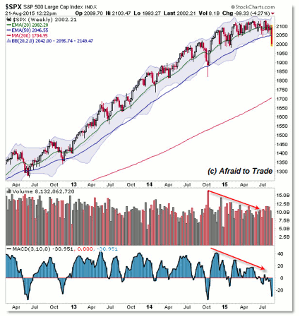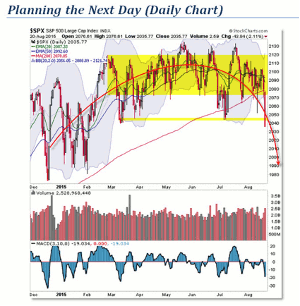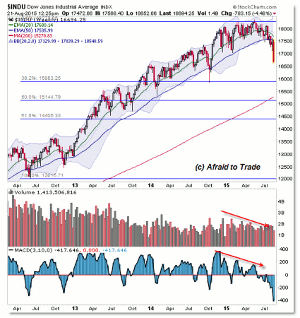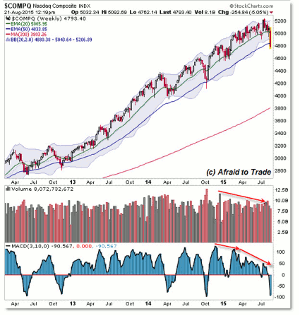As of last Friday, stocks had extremely high odds of breaking lower into a steep retracement, so technician Corey Rosenbloom, of AfraidToTrade.com, takes to the charts to update his weekly chart perspective by noting what happened, what preceded it, and what might be done about it now.
Given the negative divergences in momentum, volume, breadth, and market internals—along with the arc trend line distribution pattern—stocks had extremely high odds of breaking lower into a steep retracement.
As of last Friday, that’s precisely what they’ve done this week, right on schedule (or perhaps a little overdue).
Let’s update our Weekly Perspective charts of the Dow Jones, S&P 500, and NASDAQ to note what’s happened, what preceded it, and more importantly, what do we do now?
We’ll Start as Usual with the S&P 500 (SPX) Weekly Chart:
Under the stimulus of QE3, stocks rallied in a stable, persistent uptrend from 2013 into late 2014.
From 2015 to this week, stocks traded in a sideways distribution—or arc pattern—complete with lengthy negative divergences in momentum, volume, and Breadth.
Here’s a Specific Planning Chart from Last Thursday Night’s Idealized Trades Member Strategy Report:
The quote in blue is from last Wednesday’s report, while the quote below is from last Thursday’s report:
“At the moment, that appears to be exactly what’s happening.
Price was in distribution mode with declining (deteriorating/diverging) Breadth and Market Internals and—as I noted—virtually every chart-based metric argued for lower prices.
As long as price remains under—and moving down away from—the 2,045 target level (achieved), then we’ll expect a continued larger retracement toward 2,000 or even 1,980.”
Note the Rounded Arc arrow that pointed straight toward 2,000, exactly where we are as of Friday.
This big sell-off should not be a surprise.
For now, we’re focusing on the 2,000 round number reference target (achieved) and marking it as our short-term pivot.
Beneath lies 1,180 if sellers continue to push this market lower in ongoing distribution.
The Dow Jones Index Is Weaker Than the S&P 500:
We see the same negative divergences in virtually all metrics in the Dow Jones.
Price failed just above the 18,000 level and then broke impulsively this week under the 17,500 pivot.
The result was a logical and expected deep retracement straight toward 17,000 and now the 16,500 level.
I expanded the perspective to show key longer-term Fibonacci retracement levels in the event price does continue its steep retracement to lower support targets.
The first major target—price and Fibonacci—would be the 16,000 target.
Finally, the NASDAQ Is the Strongest of the Three Main US Stock Market Indexes:
While the S&P 500 and NASDAQ developed a sideways trading range, the NASDAQ continued trading higher, albeit within the context of a lengthy negative divergence environment.
When the NASDAQ broke under the 5,000 level, it set in motion the current collapse toward the rising 50-week EMA near 4,800 where price trades as of Friday.
As you study these charts, the broader trends, and the probability for either a support-bounce at current target levels or a continuation of the retracement to lower support levels, be sure to focus on the indicator factors—mainly the divergences—that set the stage for the current volatile action.
By Corey Rosenbloom, CMT, Trader and Blogger, AfraidToTrade.com

























